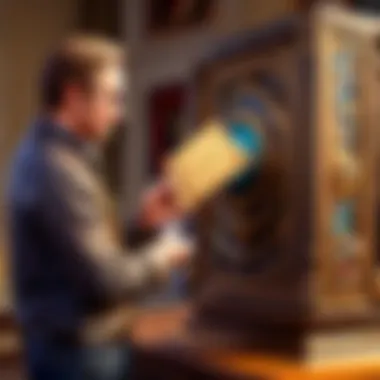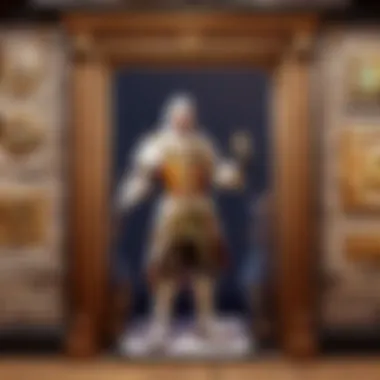Unveiling the Vital Role of a Museum Curator in Safeguarding Cultural Heritage


The Vital Role of a Museum Curator in Safeguarding Cultural Heritage
A museum curator stands as a guardian, entrusted with the crucial task of preserving and showcasing cultural heritage for present and future generations. This in-depth exploration highlights the multifaceted responsibilities and impact of these custodians of history. From the acquisition of priceless artifacts to the meticulous curation of immersive exhibitions, a museum curator serves as a bridge between past narratives and contemporary audiences.
Acquiring Precious Artifacts: The Foundation of Preserving History
Central to a curator's role is the discerning selection and acquisition of rare and significant artifacts. These artifacts are not mere objects; they are tangible links to bygone eras, offering a glimpse into the lives, beliefs, and innovations of civilizations long past. Through strategic collaborations with donors, auction houses, and archaeological expeditions, curators source and secure these treasures, ensuring their safekeeping and accessibility for scholarly study and public appreciation.
Crafting Engaging Exhibitions: Illuminating Cultural Narratives
Once in possession of these treasures, curators embark on a creative journey to breathe life into historical narratives. By thoughtfully curating exhibitions, they transcend the confines of time and space, enabling visitors to immerse themselves in the sights, sounds, and stories of diverse cultures. Through compelling display techniques, such as interactive installations, multimedia presentations, and thematic showcases, curators evoke a sense of connection and understanding, fostering dialogue and empathy across cultural boundaries.
Educating Through Interpretation: Fostering Cultural Awareness
Beyond the physical preservation of artifacts and the presentation of exhibitions lies the curator's role as an interpreter and educator. Armed with scholarly expertise and a passion for storytelling, curators contextualize historical objects, elucidating their significance and relevance to contemporary issues. Through guided tours, lectures, and educational programs, curators bridge the gap between the past and the present, imparting valuable insights that encourage critical thinking, cultural appreciation, and a sense of shared heritage.
Conclusion
Introduction
A museum curator plays a critical role in the preservation and presentation of cultural heritage. This section delves into the intricacies of a curator's responsibilities, detailing how they acquire, preserve, and exhibit artifacts to educate the public about diverse cultures. By understanding the role of a museum curator, one can grasp the significance of their contributions to safeguarding history and ensuring its accessibility to present and future generations.
Definition and Importance of a Museum Curator
Understanding the Role of a Museum Curator
Exploring the role of a museum curator sheds light on their pivotal position in cultural heritage preservation. The curator serves as a custodian of history, meticulously selecting and managing artifacts to tell compelling stories and preserve the essence of bygone eras. Their expertise in historical interpretation and curation techniques spearheads the immersive experience of museum visitors, fostering a deeper appreciation for cultural diversity and legacy. Understanding the role of a museum curator unravels the layers of meticulous care and scholarly acumen necessary to uphold the integrity of historical narratives within museum spaces.
The Significance of Cultural Heritage Preservation
Delving into the significance of cultural heritage preservation underscores its irreplaceable value in society. Cultural heritage embodies the collective memory of a community, encapsulating traditions, beliefs, and artistic expressions that define its identity. Preservation ensures that this heritage endures for future generations to learn from and cherish. By safeguarding cultural heritage, museum curators not only protect tangible artifacts but also celebrate intangible aspects of human creativity and resilience. The significance of cultural heritage preservation lies in its role as a bridge between the past and the present, offering profound insights into the evolution of societies and fostering cultural dialogue and understanding.
Overview of Cultural Heritage
Defining Cultural Heritage
Defining cultural heritage involves recognizing the diverse forms of expression and legacy that communities pass down through generations. From historic monuments to intangible traditions, cultural heritage embodies the identity and values of different societies. Understanding and preserving this heritage enriches societal narratives and fosters a sense of belonging and continuity. By defining cultural heritage, museum curators empower communities to embrace their roots and appreciate the multifaceted dimensions of human creativity and experience.
Importance of Cultural Heritage in Society


The importance of cultural heritage in society transcends mere preservation; it encompasses the very essence of human existence and evolution. Cultural heritage serves as a repository of knowledge, reflecting the cultural, social, and economic aspects of past civilizations. By acknowledging and valuing cultural heritage, societies acknowledge the diverse contributions and innovations of their ancestors. This acknowledgment promotes cultural diversity, mutual respect, and historical consciousness, laying the foundation for building inclusive and harmonious societies.
Responsibilities of a Museum Curator
In this section, we delve into the pivotal role of a museum curator in preserving a society's cultural heritage. Museum curators serve as the guardians of history, responsible for acquiring, preserving, and showcasing artifacts that provide insights into our past. Their meticulous work ensures that these artifacts are not only safeguarded for future generations but also used to educate the public about the diverse cultures that enrich our world.
Artifact Acquisition
Sourcing and Collecting Artifacts
When it comes to the acquisition of artifacts, museum curators must carefully source and collect items that are historically significant and culturally relevant. Their skill in identifying valuable pieces plays a crucial role in enriching the museum's collection and furthering our understanding of ancient civilizations. By meticulously evaluating and selecting artifacts, curators contribute to creating a comprehensive narrative that reflects the intricacies of human history.
Ensuring Authenticity and Ethical Practices
Authenticity and ethical practices are paramount in the field of artifact acquisition. Museum curators are tasked with verifying the provenance of artifacts to ensure they are not looted or illegally obtained. By upholding stringent ethical standards, curators maintain the integrity of the museum's collection and avoid perpetuating illicit trade practices. Their commitment to authenticity guarantees that visitors can trust the accuracy and legitimacy of the displayed artifacts, fostering a sense of respect and credibility within the museum community.
Exhibition Curation
Designing Engaging Exhibits
In the realm of exhibition curation, museum curators craft captivating displays that resonate with visitors and convey compelling narratives. The art of designing engaging exhibits involves conceptualizing thematic frameworks, selecting relevant artifacts, and creating immersive experiences that stimulate curiosity and learning. Through innovative presentation techniques and creative storytelling, curators transform historical facts into visually striking and intellectually stimulating exhibitions that engage diverse audiences.
Educational Value of Exhibition Curation
Beyond their aesthetic appeal, exhibitions curated by museum professionals have substantial educational value. By curating exhibitions that are intellectually enriching and thought-provoking, curators serve as educators who impart knowledge and foster critical thinking skills among visitors. Through interactive elements, interpretive materials, and engaging multimedia content, curated exhibits become dynamic platforms for cultural exchange and learning, transcending traditional notions of passive museum viewing.
Research and Documentation
Conducting Historical Research
Research forms the backbone of a curator's work, as it involves delving into archives, libraries, and scholarly resources to uncover the historical context of artifacts. Curators engage in rigorous academic inquiry to authenticate, contextualize, and interpret the objects in their care, shedding light on their significance within broader socio-cultural frameworks. By conducting thorough historical research, curators reconstruct narratives that bring the past to life and offer nuanced insights into the complexities of human heritage.
Maintaining Detailed Records
Documentation is a critical aspect of curatorial responsibilities, as curators meticulously catalogue and record essential information about each artifact in their collection. By maintaining comprehensive records that encompass provenance, condition reports, and exhibition histories, curators establish a systematic archive that aids in research, conservation, and provenance research. The meticulous record-keeping practices of curators ensure transparency, accountability, and accessibility within museum collections, facilitating scholarly inquiry and public engagement.
Conservation and Restoration
Preserving Artifacts
Preserving artifacts is a fundamental duty of museum curators, who employ specialized conservation techniques to safeguard objects from deterioration and decay. By implementing preventative conservation measures such as proper lighting, climate control, and handling protocols, curators prolong the lifespan of artifacts and protect them from environmental hazards. The preservation of artifacts ensures their longevity and enables future generations to benefit from these invaluable cultural treasures.


Implementing Conservation Techniques
Practicing conservation involves the application of scientific methods and ethical principles to conserve and restore cultural heritage objects. Museum curators collaborate with conservators, scientists, and experts to develop conservation strategies that address the unique material composition and condition of each artifact. Through careful analysis, treatment, and documentation, curators ensure that conservation interventions are informed by scholarly research and adhere to professional standards. By implementing conservation techniques, curators fulfill their mandate to uphold the integrity and authenticity of museum collections, safeguarding these artifacts for posterity and promoting heritage conservation practices.
Qualifications and Skills
In the realm of museum curation, the importance of qualifications and skills cannot be overstated. Museum curators are entrusted with the monumental task of preserving cultural heritage for future generations. This requires a unique blend of educational background and critical skills to effectively manage and showcase artifacts of historical significance. The expertise and acumen of a museum curator directly impact the quality of exhibitions and the depth of historical narratives presented to the public. Therefore, emphasizing the significance of qualifications and skills in this domain becomes paramount.
Educational Background
Relevant Degrees
When delving into the realm of relevant degrees for museum curators, one must consider the specialized fields that contribute to the understanding and preservation of cultural heritage. Degrees in fields such as art history, archaeology, museum studies, or anthropology equip individuals with the necessary knowledge and expertise to navigate the complexities of artifact preservation and exhibition curation. These degrees offer a comprehensive understanding of historical contexts, preservation techniques, and curatorial practices, thereby establishing a strong foundation for aspiring museum curators. The immersive nature of these programs enables individuals to gain practical experience in artifact management and conservation, ensuring they are well-prepared to tackle the challenges of the curation process.
Specialized Courses
In addition to relevant degrees, the importance of specialized courses for museum curators cannot be overlooked. These courses provide focused training in areas such as conservation techniques, archival management, exhibition design, and cultural heritage preservation. By honing their skills through specialized courses, museum curators can stay abreast of industry trends, technological advancements, and ethical considerations in the field of curation. The hands-on nature of these courses allows curators to apply theoretical knowledge to real-world scenarios, enhancing their capacity to make informed decisions regarding artifact acquisition, exhibition planning, and conservation practices. While specialized courses offer valuable insights and practical skills, they also present challenges such as the need to constantly update knowledge and adapt to evolving best practices in museum curation.
Critical Skills
Attention to Detail
Attention to detail stands as a cornerstone of success for museum curators engaged in preserving cultural heritage. The meticulous examination of artifacts, historical documents, and exhibition layouts requires an acute eye for precision and accuracy. Museum curators must meticulously catalog and document every aspect of the curation process, ensuring that no detail is overlooked in the preservation of cultural treasures. This level of scrutiny guarantees the authenticity and integrity of exhibitions, fostering a deeper connection between the audience and the historical narratives being portrayed.
Organizational Skills
Complementing attention to detail, organizational skills play a vital role in the seamless execution of a museum curator's responsibilities. From managing artifact collections to coordinating exhibition schedules, organizational prowess enables curators to maintain order amidst the multifaceted demands of curation. The ability to prioritize tasks, allocate resources effectively, and streamline workflow processes enhances the efficiency and efficacy of cultural heritage preservation efforts. Organizational skills empower museum curators to uphold professional standards, meet project deadlines, and navigate logistical challenges with finesse, ultimately enriching the visitor experience and preserving the cultural legacy enshrined within museum walls.
Challenges Faced by Museum Curators
When delving into the meticulous world of museum curation, it becomes evident that museum curators are often confronted with a myriad of challenges that threaten the smooth operation and preservation of cultural heritage. These challenges are not merely hurdles to overcome but intricate puzzles that require strategic solutions for the seamless continuation of their vital work in cultural conservation and presentation. As pivotal gatekeepers of history, museum curators face a constant battle against funding constraints and ethical dilemmas, highlighting the delicate balance they must maintain between financial sustainability and ethical integrity.
Funding Constraints
Securing Financial Support
In the realm of museum curation, securing financial support stands as a fundamental pillar that upholds the entire structure of cultural preservation. The ability to secure funds determines the extent to which a museum curator can acquire new artifacts, maintain existing collections, and orchestrate engaging exhibitions that captivate audiences. The process of securing financial support involves navigating complex funding sources, such as grants, sponsorships, and donations, which necessitates a keen eye for detail and a strategic approach. While financial support propels the mission of cultural heritage preservation forward, it also poses challenges in ensuring sustainable funding streams amidst fluctuating economic landscapes. Museum curators must adeptly balance the allure of financial resources with the overarching goal of maintaining the museum's autonomy and integrity, thereby underscoring the critical role of securing financial support in the intricate tapestry of museum curation.
Balancing Budgets


Within the landscape of museum curation, balancing budgets emerges as a cornerstone of financial stewardship that demands meticulous attention to detail and strategic allocation of resources. The intricate dance of balancing budgets involves juggling operational costs, conservation expenses, exhibition expenditures, and staff remuneration while adhering to the overarching financial constraints that govern the museum's fiscal health. Museum curators face the arduous task of optimizing resources to maximize the impact of their cultural preservation efforts while treading the fine line between fiscal prudence and visionary investment. The art of balancing budgets is not merely about monetary figures but embodies a nuanced understanding of prioritization, long-term sustainability, and prudent financial decision-making that ensures the continuity and prosperity of the museum's mission.
Ethical Dilemmas
Ethical dilemmas represent a formidable terrain that museum curators navigate with caution and foresight, as they grapple with contentious issues surrounding the repatriation of artifacts and the presentation of controversial exhibits. These ethical quandaries underscore the ethical compass that guides the practices of museum curators, illuminating their unwavering commitment to integrity and inclusivity in cultural representation.
Repatriation of Artifacts
The discourse surrounding the repatriation of artifacts encapsulates the complex interplay between cultural ownership, historical restitution, and ethical stewardship within the realm of museum curation. Museum curators are often confronted with decisions regarding the repatriation of artifacts to their countries of origin, necessitating a nuanced understanding of colonial legacies, indigenous rights, and cultural heritage preservation. The repatriation process is not merely a logistical endeavor but a moral imperative that underscores the museum's responsibility to rectify historical injustices, honor diverse cultural narratives, and foster collaborative relationships with source communities. While repatriation symbolizes a step towards reconciliation and social justice, it also presents challenges in navigating legal frameworks, diplomatic protocols, and ethical considerations that shape the ethical landscape of museum curation.
Dealing with Controversial Exhibits
The task of dealing with controversial exhibits places museum curators at the nexus of representation, interpretation, and societal discourse, requiring deft navigation of sensitive subject matter and divergent perspectives. Controversial exhibits have the potential to spark dialogue, provoke thought, and challenge normative narratives, yet they also entail risks of misinterpretation, backlash, and ethical scrutiny. Museum curators must tread a careful path in curating controversial exhibits, balancing the imperative of intellectual freedom with the ethical responsibility of contextualization and sensitivity. Handling controversial exhibits demands a blend of scholarly rigor, community engagement, and cultural diplomacy to ensure that diverse voices are heard, historical truths are upheld, and ethical considerations are paramount in the exhibition narrative. In essence, dealing with controversial exhibits encompasses a delicate dance between intellectual provocativeness and ethical stewardship, underscoring the nuanced approach that museum curators must adopt in navigating complex ethical dilemmas within the realm of cultural heritage preservation.
Technological Advancements in Curation
In this article, the focus shifts towards exploring the critical aspect of technological advancements in curation within the context of museum curator roles. Technological advancements have revolutionized the museum sector, offering innovative solutions to preserve and present cultural heritage more efficiently and interactively. This section dives deep into the impact of technology on the traditional practices of curation and how it influences the overall presentation of historical artifacts and information.
Digital Curation Tools
- Virtual Exhibits:
Virtual Exhibits:
Virtual exhibits stand out as a pivotal tool in modern museology, enabling museums to create immersive digital displays accessible to a global audience. By leveraging virtual exhibits, curators can showcase artifacts in a simulated, interactive setting, providing viewers with a nuanced understanding of historical contexts. The ability to reach individuals worldwide and offer a personalized exploration experience makes virtual exhibits a valuable addition to museums, enhancing engagement and educational outreach. However, challenges such as ensuring accurate representation of physical artifacts in a digital format and maintaining user interest pose notable considerations for curators utilizing virtual exhibits.
- Online Archiving Systems:
Online Archiving Systems:
Online archiving systems play a crucial role in digital preservation and accessibility of cultural resources. These systems facilitate the cataloging and storage of vast collections, ensuring long-term conservation and convenient retrieval of heritage materials. The interconnected nature of online archiving systems boosts collaboration among institutions and researchers, fostering a more comprehensive understanding and utilization of cultural assets. While online archiving systems offer unparalleled opportunities for information dissemination and research, issues related to data security, authenticity, and sustainability require continuous attention from museum professionals.
Enhanced Visitor Experiences
Delving deeper into enhancing visitor experiences within museum spaces, this section emphasizes the integration of interactive technologies to captivate audiences and foster deeper connections with cultural heritage.
- Interactive Displays:
Interactive Displays:
Interactive displays serve as dynamic platforms that encourage visitor engagement and learning through hands-on exploration of exhibits. By incorporating touchscreens, multimedia content, and interactive features, museums can cater to diverse learning styles and heighten visitor immersion in historical narratives. The interactive nature of these displays cultivates a more interactive and memorable museum visit, amplifying educational outcomes and fostering a lasting interest in cultural heritage. However, optimizing user interface design and content relevance remains essential for maximizing the effectiveness of interactive displays.
- Augmented Reality Applications:
Augmented Reality Applications:
Augmented reality applications offer an innovative approach to augmenting physical exhibits with digital overlays, providing users with enhanced sensory experiences and storytelling elements. By superimposing digital information onto the real-world environment, augmented reality enriches visitor perceptions and deepens their understanding of exhibited artifacts. The blend of physical and virtual realities through augmented reality applications heightens visitor engagement and enables a personalized exploration of cultural heritage, revolutionizing the conventional museum experience. Nonetheless, considerations such as technology accessibility and maintenance effectivity warrant strategic planning for successful implementation and utilization of augmented reality applications in museum settings.







